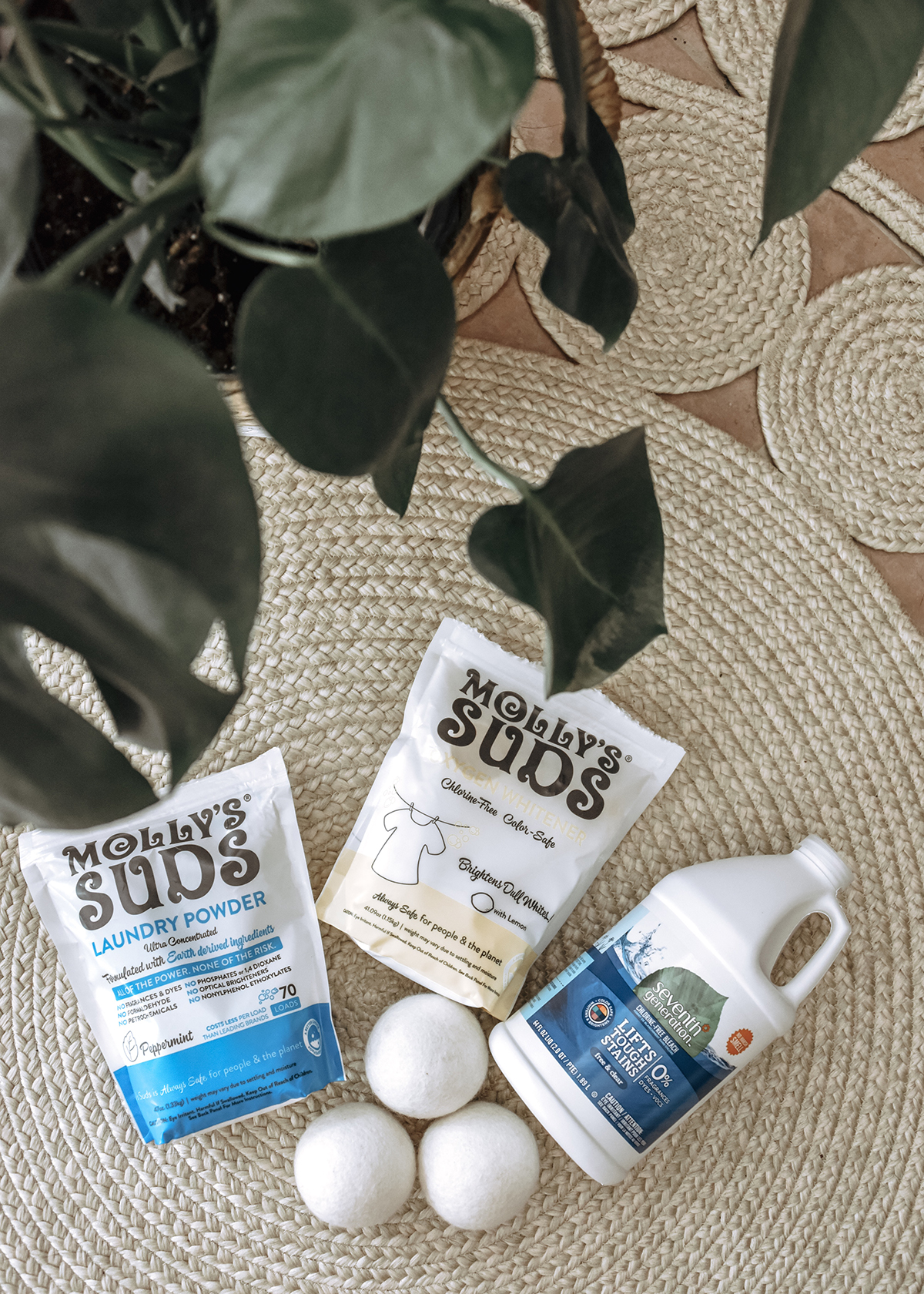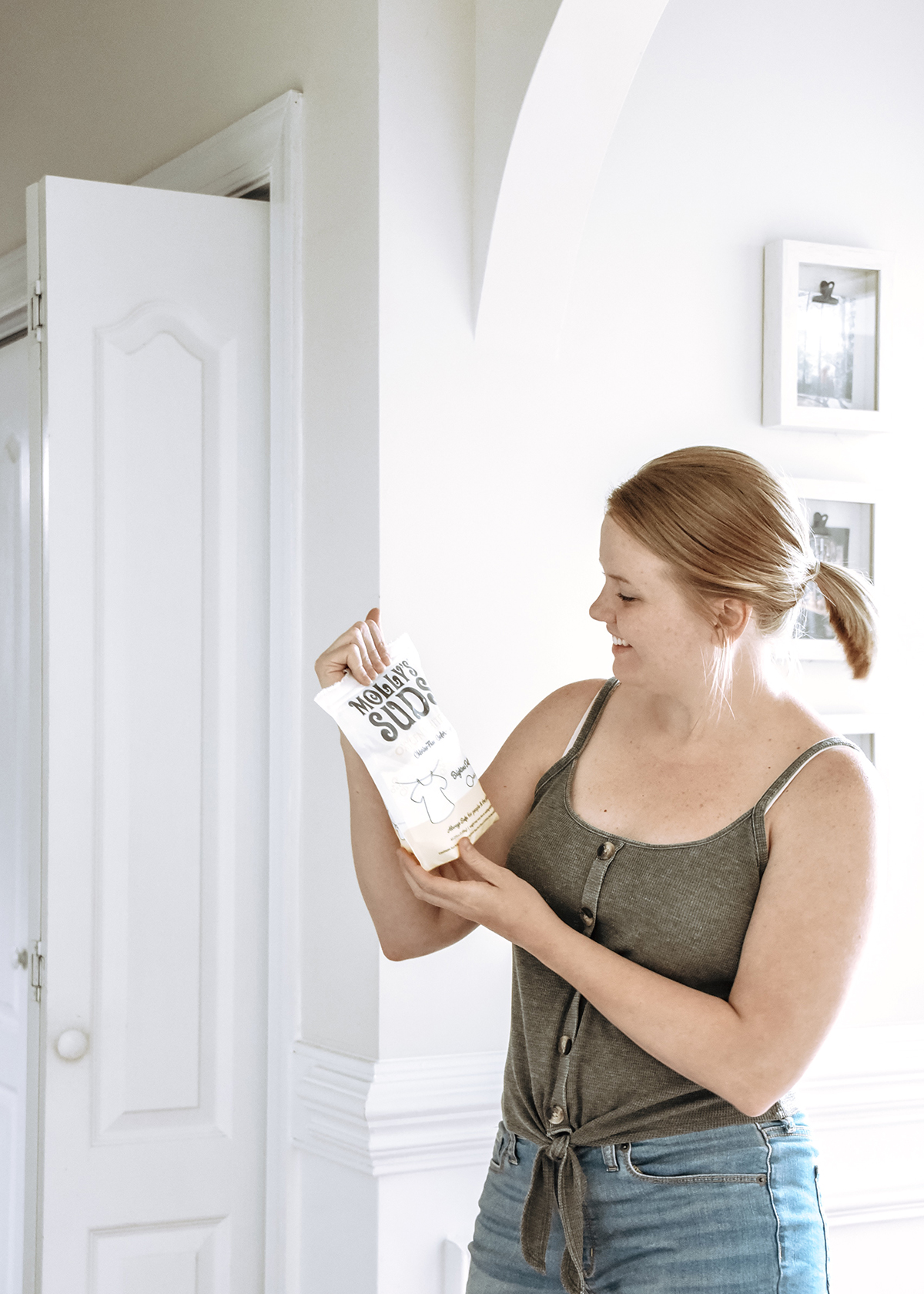Disclosure: As a Grove Collaborative Partner, I receive compensation when you sign up for their delivery service and complete your first order. All opinions expressed are my own.
Did you know that in a jug of a popular brand of unscented (sensitive skin formula) liquid laundry detergent, 7 out of its 11 ingredients are known to cause skin irritation, damage to DNA, respiratory issues, and endocrine system disruption, as well as nervous system effects and vision damage, among other awful things?
A month ago, that popular brand (not tossing out any names) was my go-to for laundry detergent and had been for 10-plus years.
However, as I have been learning more and more about household cleaning products and their ingredients, I have been able to identify major areas of concern by using the Environmental Working Group’s Guide to Healthy Cleaning.

This wonderful online resource has helped me immensely over the last few months as I have been working toward a more natural, environmentally-friendly lifestyle. It has also helped me realize that household products I thought were “clean,” actually aren’t. In some cases, those products were some of the worst rated as far as ingredient toxicity goes.

Something I greatly appreciate about EWG is that they never endorse specific brands or products. Their Guide to Healthy Cleaning was created for educational purposes, to help consumers make better choices when buying cleaning products.
The Guide to Healthy Cleaning is just one of the consumer guides EWG provides, and it contains information and hazard assessments for more than 2,000 products, 197 brands and more than 1,000 ingredients.
It’s easy to hop on their website, search for a specific product you want to check on, and see how EWG has graded that product’s ingredients.
Ingredients are rated using an “A” through “F” scale, with “A” being least concerning for toxicity, health, and environmental impact.
About EWG:
EWG’s Guide to Healthy Cleaning
Environmental Working Group’s mission is to use the power of information to protect human health and the environment. EWG’s Guide to Healthy Cleaning gives you practical solutions to protect yourself and your family from everyday exposures to potentially harmful chemicals. U.S. law allows manufacturers of cleaning products to use almost any ingredient they wish, including known carcinogens and substances that can harm fetal and infant development. And the government doesn’t review the safety of products before they’re sold. To fill those gaps, EWG’s staff scientists compared the ingredients listed on cleaning product labels, websites and worker safety documents with the information available in the top government, industry and academic toxicity databases and the scientific literature on health and environmental problems tied to cleaning products. They used that information to create EWG’s Guide to Healthy Cleaning, which provides you with easy-to-navigate hazard ratings for a wide range of cleaners and ingredients.
With all of that in mind, I decided to take a look at my laundry routine and see how my most-used products measured up on the EWG Guide to Healthy Cleaning. Let me just say, none of the laundry-care items I was using had above a “D” rating.
I already told you my laundry detergent was loaded with ingredients that are harmful to not only my home and family but to the environment, as well. My beloved dryer sheets and bleach, however, were even worse.
Once I saw those ratings I knew I needed to “clean up” my laundry routine ASAP.

Naturally, I turned to Grove Collaborative — an online subscription service that delivers all-natural home, beauty, and personal care products directly to your door — to help me find replacements for my detergent, dryer sheets, and bleach. I only wanted laundry care products that are rated “A” or “B” by EWG.
I have been using Grove Collaborative for almost a year to easily transition our most-used household products to ones that are better for us.
{P.S., you can get a free gift set from Grove Collaborative when you sign-up today.}
With a little digging on Grove Collaborative and comparing their laundry care products to the EWG database, here are the four items I am now using for my laundry routine:
Molly’s Suds Laundry Powder (scented with peppermint oil)

Rated “A” by EWG.
This powder detergent is made with only five ingredients, all of which pose no cause for concern. This product is not tested on animals, is made in the USA, and is Leaping Bunny Certified. I also appreciate that Molly’s Suds is a women owned business.
Quality is not compromised with this product, either. I have really enjoyed using it and love how fresh my laundry smells after washing with Molly’s Suds. The first thing I noticed after using it was how clean my laundry felt. It simply feels different than it did when I was using liquid detergent. Plus, a little goes a long way. The 47-ounce bag from Grove Collaborative produces 70 loads; the recommended amount of powder per load is only 1 tablespoon.

The Oxygen Whitener from Molly’s Suds is not available on EWG, but a quick ingredient search in the EWG database reveals that the 3 main ingredients are rated “A.”
I highly recommend that if you can’t find a specific product on EWG, look at the ingredients on the label and plug those into the EWG search bar. EWG maintains an extensive list of ingredients and rates them according to their level of toxicity.
Molly’s Suds Oxygen Whitener is a wonderful bleach alternative that uses sodium percarbonate as the main ingredient to brighten your white clothes and linens.
You can soak your laundry in it with warm water for more brilliant whites or simply add it to your wash as a booster (which is what I do). It is also incredibly versatile in that it can be used with your carpet steam cleaner for stain removal, or it can be used to clean your toilets to make them shine.
Seventh Generation Chlorine-Free Bleach

Rated “A” by EWG.
Yes, you read that correctly. That is bleach on my “clean” laundry essentials list.
Regular bleach is a “no, no” in the world of better-for-you household cleaning essentials. It is recommended that bleach should be avoided all costs because the ingredients have severe health and environmental concerns. Which is difficult for me since I grew up in a home where bleach was used to clean absolutely everything.
For reference, a jug of a popular brand of bleach is rated “F” by EWG.
The Seventh Generation Chlorine-Free Bleach, however, is different because it is made only with water and hydrogen peroxide (which is considered by EWG as a safer ingredient).
I particularly love that it doesn’t have a “bleachy” smell, and the hydrogen peroxide is a great stain lifter. Plus, it is color-safe.

The final laundry product I want to share are these wool dryer balls I use to replace my dryer sheets.
The set of 3 wool dryer balls from Grove Collaborative are chemical-free and made from 100 percent pure New Zealand wool.
Dryer sheets and fabric softeners are some of the worst laundry products you can use. In fact, EWG has an entire disclosure devoted to fabric softeners:
What about fabric softeners?
Don’t use them — they’re unnecessary and contain potentially harmful chemicals. Fabric softeners and dryer sheets coat your clothes with a layer of chemicals, most commonly “quats” (short for quaternary ammonium compounds).The Association of Occupational and Environmental Clinics, a leading international authority on asthma, calls many of these chemicals “asthmagens,” substances that can cause asthma to develop in otherwise healthy people. Many quats also have antibacterial qualities. While it might sound useful to keep clothes germ-free, freshly washed clothes are already plenty clean. Overuse of quats may spur development of antibiotic-resistant superbugs.
Most fabric softeners and dryer sheets contain fragrances, actually made up of hundreds of untested chemicals including toxic ingredients such as phthalates and synthetic musks – both suspected hormone disruptors. Fragrances are among the world’s top five allergens.
A 2010 University of Washington study on air contaminants from fragranced consumer goods detected between 18 and 20 chemicals in each of four laundry products tested – including the likely human carcinogens acetaldehyde and 1,4-dioxane, the developmental toxicants methyl ethyl ketone and chloromethane, and allergens like linalool. These chemicals don’t belong in your laundry and your neighbors probably don’t want them in the dryer air that vents in their direction.
A natural fabric softener is 1/2 cup of white vinegar per load during the rinse cycle.
Environmental Working Group
To use the wool dryer balls, all I do is load my wet clothes into my dryer and toss in all 3 wool balls.
I like to add about 3 drops of my favorite essential oils to the wool balls before putting them in with my clothes, just to add some scent. Currently, I alternate between Young Living’s Lavender and Orange essential oils. Young Living is simply my preferred brand of essential oils.
Grove Collaborative does carry some essential oils, though.

If cleaning up your laundry routine is important to you (actually, even if it’s not on your radar), I recommend that you look up all of your current laundry care essentials on EWG’s Guide to Healthy Cleaning and see what they are rated. I can’t encourage you enough to be a knowledgeable consumer and know what you are bringing into your home.

These products are the four I highly recommend to start with if you are looking to make a change, but Grove Collaborative has plenty of additional laundry care products for you to peruse.




